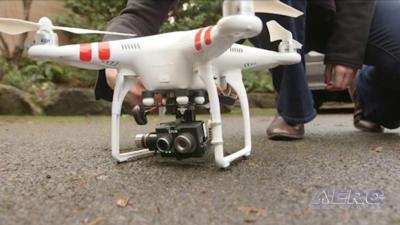Law Covering Drones Equipped With Cameras Changed August 1
Last fall, the Swedish Supreme Administrative Court ruled that a camera mounted on a drone is considered a CCTV camera for purposes of the Swedish Camera Surveillance Act. The judgment meant that using a drone equipped with a camera, where the camera will be directed at a place to which the public has access, requires a license from the County Administrative Board.

Since a license in principle is granted only for the prevention of crime, the normal commercial and recreational use of a drone equipped with a camera immediately became for practical purposes prohibited in Sweden. New legislation has now been passed to exempt the private use of drone cameras from the permit requirements, making drone use in Sweden legal again on August 1, 2017.
The Swedish Transport Agency estimates that there are between 50,000 and 100,000 drones, also known as unmanned aircraft systems (UASs), for recreational use in Sweden. In addition, the Transport Agency has issued a little over 1,510 permits for drones for commercial use. As in many other countries, drones are finding an increasing number of commercial applications. Apart from news and other media applications, drones are, e.g. used for surveying, inspection and aerial photography by real property brokers.
As in many countries, civil unmanned aircraft in Sweden are regulated by aviation regulations, specifically the Swedish Transport Agency’s Regulation on unmanned aircraft—UAS. Permission for these is applied for through EASA. Sweden had also passed additional regulations applying to drones and the distribution of aerial photographs.
The Supreme Administrative Court ruled, in a judgment of October 2016, that camera-equipped drones are also covered by the Swedish Camera Surveillance Act. Under this Act, directing CCTV cameras towards an area to which the public has access requires a license from the County Administrative Board. In the assessment of whether a license will be granted, the County Administrative Board will weigh the interest for surveillance against the interest of integrity. In principle, a licence will be granted only to prevent crime, meaning that no licences would be granted for commercial or recreational purposes. In the aftermath of the judgment, serious concerns were raised in Swedish society and business that the judgment would stifle the rapidly growing drone industry and prevent legitimate and beneficial uses of drone technology, e.g. within rescue work, forestry and agriculture, as well as journalism.
Against this background, the Swedish Ministry of Justice moved swiftly to draw up a legislative proposal in the form of a memorandum entitled The Camera Surveillance Act and the possibilities to use drones for legitimate purposes. In brief, the key proposal of the memorandum was to exempt the application of the Camera Surveillance Act to surveillance conducted by a camera mounted on a drone, provided that the surveillance is not undertaken by a government agency. The memorandum was referred for consideration to a number of relevant bodies in Sweden, including central government agencies, special interest groups, local government authorities and other bodies whose activities might be affected by the proposals. Although some concerns were raised on the basis of privacy, a vast majority of the referral bodies were positive to the proposal.
As a result, the Government in May proposed and Parliament adopted a brief amendment of the Camera Surveillance Act, as follows:
“The Act shall not apply to camera surveillance from an unmanned aircraft, provided that the surveillance is conducted by a party other than a government agency.”
The legislative change entered into effect on 1 August 2017.
(Source: UAS Vision. Image from file)
 Citation Operators Get Another Flight Data Connection for QA
Citation Operators Get Another Flight Data Connection for QA ANN's Daily Aero-Linx (06.01.25)
ANN's Daily Aero-Linx (06.01.25) NTSB Final Report: Bellanca 8GCBC
NTSB Final Report: Bellanca 8GCBC Aero-News: Quote of the Day (06.01.25)
Aero-News: Quote of the Day (06.01.25) Classic Aero-TV: High-Speed Match-up - Venom and GE Rebirth A Legend
Classic Aero-TV: High-Speed Match-up - Venom and GE Rebirth A Legend



